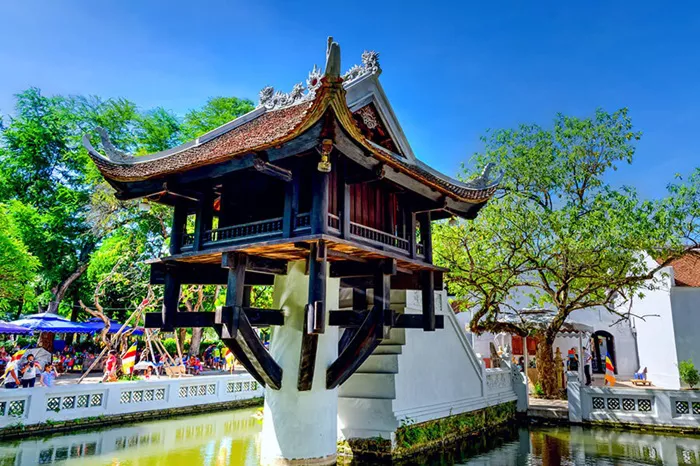The One Pillar Pagoda is one of the most famous and unique Buddhist temples in Vietnam. It is located in Hanoi, the capital city. This pagoda stands on a single stone pillar rising out of a small pond. It looks like a lotus flower, which is a symbol of purity in Buddhism. The pagoda attracts many visitors every year because of its special design and deep spiritual meaning.
The History of The One Pillar Pagoda
Origin and Construction
The One Pillar Pagoda was originally built in the year 1049 during the reign of Emperor Ly Thai Tong of the Ly Dynasty. According to legend, the emperor had a dream where the Bodhisattva Avalokiteshvara (Guan Yin) handed him a baby son while seated on a lotus flower. Inspired by this dream, the emperor built the pagoda to resemble a lotus flower emerging from the water. It was meant to honor the Bodhisattva and express gratitude for the blessing of a son.
Rebuilding and Preservation
Over centuries, the pagoda suffered damage and was destroyed several times. The most serious destruction happened during the French colonial period in the 1950s. However, it was later rebuilt in 1955 to restore its original design. Today, the pagoda is carefully preserved as an important cultural and religious symbol in Vietnam.
The Symbolism of The One Pillar Pagoda
Lotus Flower and Purity
The shape of the pagoda is meant to look like a lotus flower. In Buddhism, the lotus is a powerful symbol of purity, enlightenment, and rebirth. Just as a lotus grows from muddy water but blooms beautifully above the surface, Buddhist teachings encourage followers to rise above suffering and ignorance to reach enlightenment.
The Single Pillar Meaning
The pagoda’s single pillar represents strength and stability. It also symbolizes the idea of spiritual support that upholds the practice of Buddhism. This architectural choice is rare and shows the creativity of Buddhist architecture in Vietnam.
The Architecture of The One Pillar Pagoda
Design Features
The pagoda is small but full of artistic details. It stands about 4 meters high on a pillar that is also made from stone. The top platform is designed to look like an open lotus flower with petals spreading out. The small temple building on the pillar has a curved roof covered with traditional tiles. Inside, there is a statue of the Bodhisattva Avalokiteshvara sitting on a lotus throne.
Relationship to Buddhist Architecture
The One Pillar Pagoda reflects unique elements of buddhist architecture. Unlike many other temples built on the ground, this pagoda’s one-pillar design creates a sense of floating and lightness. This shows how architecture can represent spiritual ideas visually, connecting the physical world with Buddhist teachings.
The Spiritual Importance of The One Pillar Pagoda
Place of Worship
Though small, the pagoda is an important place for Buddhist worshipers in Vietnam. People come to pray for health, happiness, and prosperity. It is especially popular among women who pray for fertility and family blessings, following the original story of Emperor Ly Thai Tong.
Cultural and Religious Symbol
The pagoda is also a symbol of Vietnamese culture and religion. It represents the strong connection between Buddhism and Vietnamese history. Many cultural events and festivals take place at the site, which helps to keep the Buddhist tradition alive in the modern era.
Visiting The One Pillar Pagoda
Location and Accessibility
The One Pillar Pagoda is located near the Ho Chi Minh Mausoleum in Hanoi. Visitors can easily access it by taxi, bus, or on foot from the city center. It is open to the public daily, but it is best to visit early in the morning to experience the peaceful atmosphere.
What to Expect
Visitors will see the beautiful lotus-shaped pagoda standing in the middle of a small pond surrounded by a garden. There is a wooden bridge that leads to the pagoda’s base, allowing people to approach and offer prayers. The quiet and serene environment makes it a perfect place for meditation and reflection.
Respectful Behavior
When visiting, it is important to dress modestly and behave respectfully. Taking photos inside the pagoda is usually not allowed. Visitors should keep noise to a minimum and follow any instructions given by the temple staff.
The One Pillar Pagoda in Vietnamese Culture
National Symbol
The One Pillar Pagoda is often seen as a symbol of Hanoi and Vietnam. It appears in many artworks, souvenirs, and tourist brochures. It reminds people of the country’s rich Buddhist heritage and its artistic creativity.
Role in Festivals
During major Buddhist festivals, such as Vesak or Tet (Vietnamese New Year), the pagoda becomes a center of celebration. Monks and devotees gather to chant prayers and perform rituals. The pagoda also participates in cultural events that showcase traditional music, dance, and food.
Conclusion
The One Pillar Pagoda is much more than just a small temple on a stone pillar. It is a symbol of faith, history, and art. Its unique design reflects deep Buddhist meanings, especially the idea of purity and spiritual strength. For visitors and believers alike, the pagoda offers a peaceful place to connect with Buddhist teachings and Vietnamese culture.

